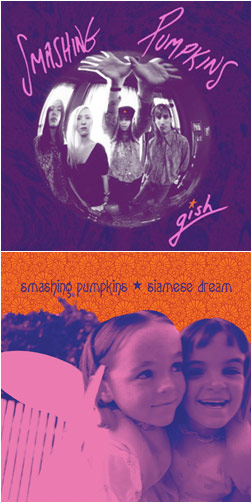
Gish and Siamese Dream Deluxe Editions
Virgin
For obvious reasons, there’s been a lot of looking back to 1991 this year. It’s been 20 years since the grungy sounds of the underground broke through to the mainstream and displaced the hair metal and vanilla pop that had long been clogging the airwaves. That year, it was hard to go a day without hearing Nirvana’s “Smells Like Teen Spirit” at least once, and Seattle had suddenly become a flanneled music epicenter overnight. Call it “the year punk broke” or whatever you like, 1991 remains a pivotal turning point that forever changed the definition of popular music.
It was also the year that Smashing Pumpkins released Gish. While the band was from Chicago and not Seattle, favored paisley over plaid flannel, and had essentially signed to a major label (Virgin subsidiary Caroline) before the Nirvana phenomenon struck, the metallic swirl of guitars coursing through their obstreperous songs was very much inline with the sounds emanating from the grunge capital. While the megalomania of the great Pumpkin himself, Billy Corgan, has tarnished the band’s reputation somewhat in the intervening years (as his recent decision to reform the band with entirely new members no doubt has as well), there’s no denying the fact that Gish was one of the significant releases of the year.
So logically, the record has been given the deluxe reissue treatment to mark its 20th anniversary, as has its successor and the Pumpkins’ big commercial breakthrough, 1993’s Siamese Dream. Packaged in purple and orange foil-wrapped boxes, each album has been paired with a bevy of ephemera: a CD of demos, outtakes and alternative mixes, a live performance on DVD, a booklet of lyrics and liner notes, and a set of postcards. They’re nice sets, if a little garish, and the auxiliary material is worth hearing/seeing.
With my interest in Smashing Pumpkins having dissipated after seeing them live (Corgan played nearly all of the guitar and bass parts on Gish and Siamese Dream, so it’s not surprising that the band didn’t measure up in the flesh), it’s probably been more than a decade since I’ve listened to either of these two albums. As such, I was caught a little off-guard by how vibrant they remain. From the opening drum and bass crescendo of “I Am One,” Gish vividly conjures 1991 without necessarily sounding dated. It’s ballsy and full of a kind bombast that might sound kitschy were it attempted today. I mean, there are solos for God’s sake! The album is layered in all kinds of guitars—whirling guitars, buzzing guitars, crunching guitars, screeching guitars, etc.—and it amounts to a tsunami of sound. At the eye of this storm are Corgan’s vocals, which are generally restrained in contrast. His distinctively plaintive croon sounds alien and otherworldly, like some spider from Mars come down to voice his angst. In the 10 minutes that comprise “Siva” and “Rhinoceros,” Corgan explores a multitude of dynamics, going, as they say, from a whisper to a scream and everywhere in between.
Siamese Dream is probably just as dramatic, but on a surface level comes off as more immediate and direct. The album leads of with “Cherub Rock,” “Quiet” and “Today,” tracks comprised of pure snap, crackle and pop, respectively. More so than most of his peers, Corgan was able to appear tough and vulnerable simultaneously, thus appealing to the widest breadth of listeners possible (i.e. girls and boys). The guitars on “Silverfuck” are fierce (more than ever now with the remastering) and emphasize Corgan’s statement of feeling “no pain” as coming from a place of strength. Siamese Dream was arena-ready, even without sounding that way in any obvious manner. In retrospect, it’s not at all surprising that the Pumpkins ascended to the peaks of the alt-rock mantle as these two records epitomize the sound that had taken over.
Stephen Slaybaugh
PAST PERFECTS
Can, Tago Mago
Leonard Cohen, The Complete Albums Collection
The Smiths, Complete
Void, Sessions 1981-83
Fac. Dance: Factory Records 12" Mixes & Rarities 1980-1987
Gregory Isaacs, The Ruler: 1972-1990
The Jimi Hendrix Experience, Winterland
Social Climbers
This May Be My Last Time Singing
Superchunk, Foolish
The George-Edwards Group, Archives
Scrawl, Velvet Hammer
Patti Smith, Outside Society
Bobb Trimble, Crippled Dog Band
